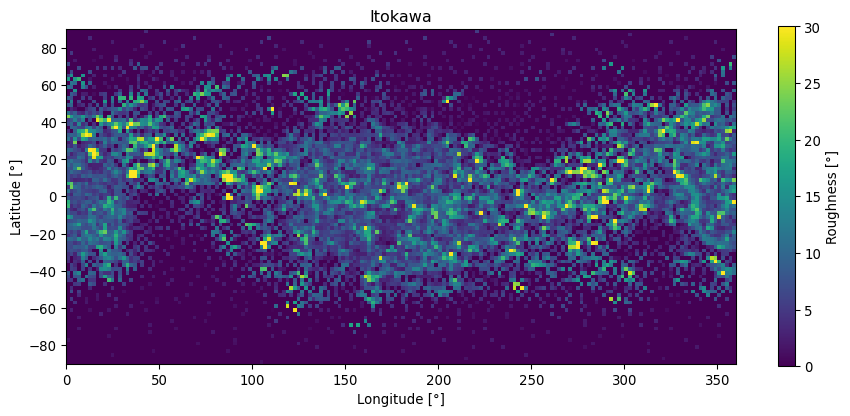Comparative study of surface roughness on Near-Earth Asteroids
- 1Institute of Planetary Research, German Aerospace Center (DLR), Berlin, Germany
- 2Freie Universität, Berlin, Germany
Introduction
Surface roughness is an important parameter used to characterize the surface of small bodies, such as asteroids and comets. Roughness measures the variability of the topography with respect to a scale of reference.
At small distances, roughness indicates physical properties of the regolith and plays a major role in interpreting data returned by imaging and thermal instruments. At mid-scale, roughness is used to identify regions of interest that may be the signature of evolutionary processes. On a global scale, roughness may hold clues to the interior structure of the asteroid.
Thanks to many space missions in the last decade, we have access to a large amount of data from various small bodies. So far, there is no comprehensive study putting together all this knowledge which will be beneficial for upcoming missions.
Small bodies of interest are the asteroids Eros, Itokawa, Bennu, Ryugu and the binary system of Didymos and Dimorphos. Previous studies focused on roughness using root mean square (RMS) deviations with different baselines: 4-200 m for Eros [1], 8-32 m Itokawa [2], 1-40 m Bennu [3], 8-60 m Ryugu [4]. Additional investigations concerned low-degree spherical harmonics and crater measurements on Bennu [5], and ejecta models for Ryugu [6].
Methodology
Roughness is typically measured as the variability (often the root mean square) of the distance between the asteroid surface and an arbitrary baseline, for a given spatial scale.
As there is no standard approach in choosing this baseline, we find that published values are often measured at different scales, and using different definitions of the reference baseline, which makes a comparative study quite challenging.
Here, we propose a unified method which defines the roughness independently from any arbitrary reference, by (1) measuring the angular variability of surface orientation on the shape models, and (2) using techniques from signal processing theory (i.e. entropy of information) that allow for a robust assessment of surface roughness from images against a wide range of photometric conditions. Al techniques are described in [7].
In this work, we investigate the roughness of 6 Near Earth Asteroids (Eros, Itokawa, Bennu, Ryugu, Didymos, Dimorphos), and perform a statistical comparison of the measured values against several parameters that relate to the asteroid state and evolution (gravity, rotation period, mass, density, composition, age).
Results
From this comparative study we will present an overview of the similarities and differences between the surfaces of these Near-Earth Objects, and propose statistical roughness scaling laws that describe the variability of the topography on asteroid surfaces. We will discuss the connection between surface roughness and evolutionary processes, in light of these new measurements, and how our work supports upcoming missions like ESA’s Hera, scheduled for launch in October 2024.

Fig. 1: Example of data product generated during our study. Map of the mean angular roughness (°) at 5 m resolution on asteroid Itokawa. The equatorial region shows higher roughness than the poles which appear to be smoother. Although the map might be slightly distorted due to Itokawa’s shape, the roughness map agrees with the different terrains which can be seen in Fig.2.

Fig. 2: Image of Itokawa with smoother and rougher regions (Credits: JAXA [8]).
References
[1] H. C. M. Susorney, O. S. Barnouin (2018). The global surface roughness of 433 Eros from the NEAR laser rangefinder. Icarus, Volume 314, p. 299-310, ISSN 0019-1035, https://doi.org/10.1016/j.icarus.2018.05.013.
[2] H. C. M. Susorney et al. (2019). The global surface roughness of 25143 Itokawa. Icarus, Volume 325, p. 141-152, ISSN 0019-1035, https://doi.org/10.1016/j.icarus.2019.01.021.
[3] H. C. M. Susorney et al. (2019). The meter-scale surface roughness of Bennu from the OSIRIS-REx mission. EPSC-DPS Joint Meeting, Switzerland, id. EPSC-DPS2019-115.
[4] Y. Masuda et al. (2020). The surface roughness of 162173 Ryugu based on the topography from Hayabusa2 Laser Altimeter (LIDAR). 51st Lunar and Planetary Science Conference, Texas, LPI Contribution No. 2326, id.2181.
[5] O. S. Barnouin et al. (2019). Shape of (101955) Bennu indicative of a rubble pile with internal stiffness. Nat. Geosci. 12, p. 247–252, https://doi.org/10.1038/s41561-019-0330-x.
[6] N. Hirata et al. (2021). Rotational effect as the possible cause of the east-west asymmetric crater rims on Ryugu observed by LIDAR data. Icarus, Volume 354, 114073, ISSN 0019-1035, https://doi.org/10.1016/j.icarus.2020.114073.
[7] JB. Vincent et al. (2023). Macro-Scale Roughness and Morphological Units on Didymos and Dimorphos. Asteroid, Comets, Meteors conference, LPI Contribution No. 2851, 2023, id. 2259.
[8] J. Saito et al. (2006). Detailed Images of Asteroid 25143 Itokawa from Hayabusa. Science, Volume 312, Issue 5778, pp. 1341-1344, DOI: 10.1126/science.1125.
How to cite: Herrmann, C. and Vincent, J.-B.: Comparative study of surface roughness on Near-Earth Asteroids, Europlanet Science Congress 2024, Berlin, Germany, 8–13 Sep 2024, EPSC2024-418, https://doi.org/10.5194/epsc2024-418, 2024.